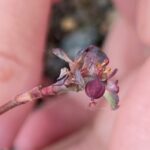Γαλατόχορτον, Γαλόχορτον, Φλόμος, Ευφορβία η κάσσια υποείδος η ριγκόεια
Etymology of Euphorbia cassia subspecies rigoi: The genus was named for "Euphorbus", a Greek physician to Juba II - King of Mauretania of Numibia. In 12 BC, Juba named a species of this genus after his physician. Euphorbus's name derives from "εὖ" [ev], meaning "good, correctly" and "φορβή" [forvi], meaning "food", thus giving the meaning somehow "provides a good meal from consumption". Euphorbus name's etymology has probably nothing to do with the naming of that Euphorbia species as the genus's plants are poisonous and non-edible. In 1753, Carolus Linnaeus, the great taxonomist, assigned the name Euphorbia, to the entire genus. The epithet "cassia" comes from the ancient Hebrew word "quetsi'oth", which means "cinnamon", first used by Dioscorides, a physician in Ancient Greece (40–90 AD), unknown why it was given to this species. The name "rigoi" was given in honour of Gregorio Rigo, an Italian pharmacist and botanist (1841-1922) who recorded it on the 19th of June, 1880 (it was identified in 1977 by A.R. Smith).
There are at least 32 kinds (species and subspecies) of the Euphorbia genus in the wild Cypriot habitat.
The genus's property as a narcotic and as a poisonous plant is due to its milky juice which is toxic and can even kill animals. In earlier times, the villagers in Cyprus used the juice of the mulberry tree to kill mice, watering bread with it.
Euphorbia cassia subspecies rigoi is a Cyprus indigenous and endemic plant. It primarily grows on rocky slopes at igneous soil and open pine forests, at very high altitudes, between 1400-1950 metres in the Troodos Mountains range. Its flowering period is between May and October.
Euphorbia cassia subspecies rigoi bears cyathia. Each cyathium consists of a single female flower and a few male flowers, accompanied by 4 or 5 greenish, broadly obovate, and nectary glands with rounded edges. The female flower consists of a single, ovoid, pedicellate, 3-locular, glabrous and superior ovary and 3 simple styles as seen in the zoomed images below.




